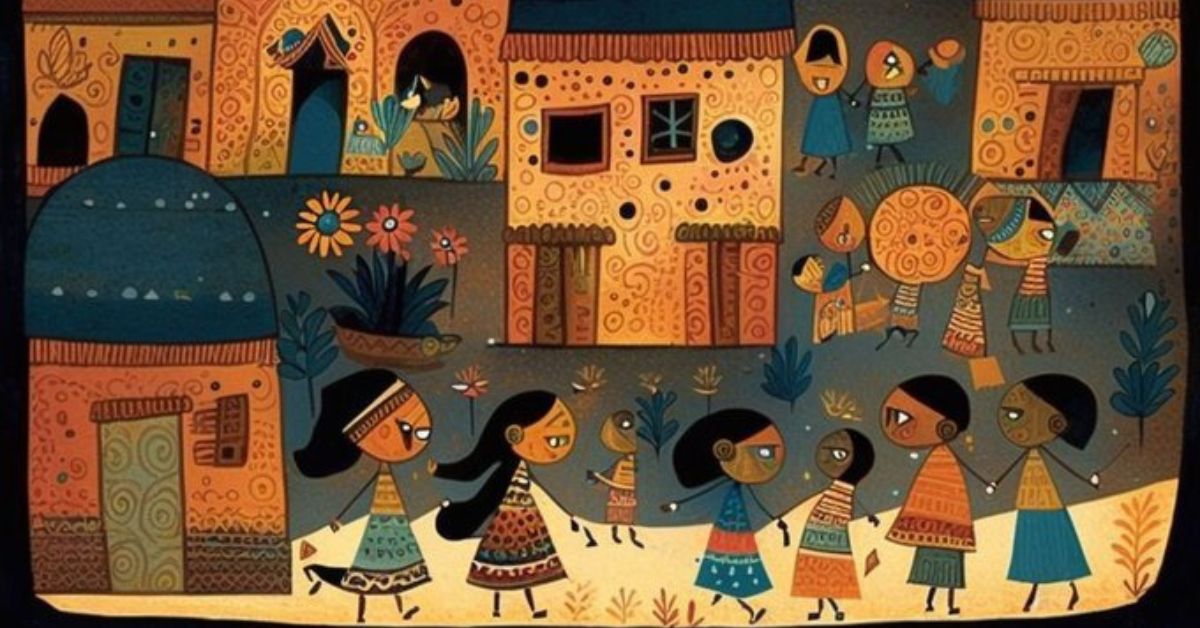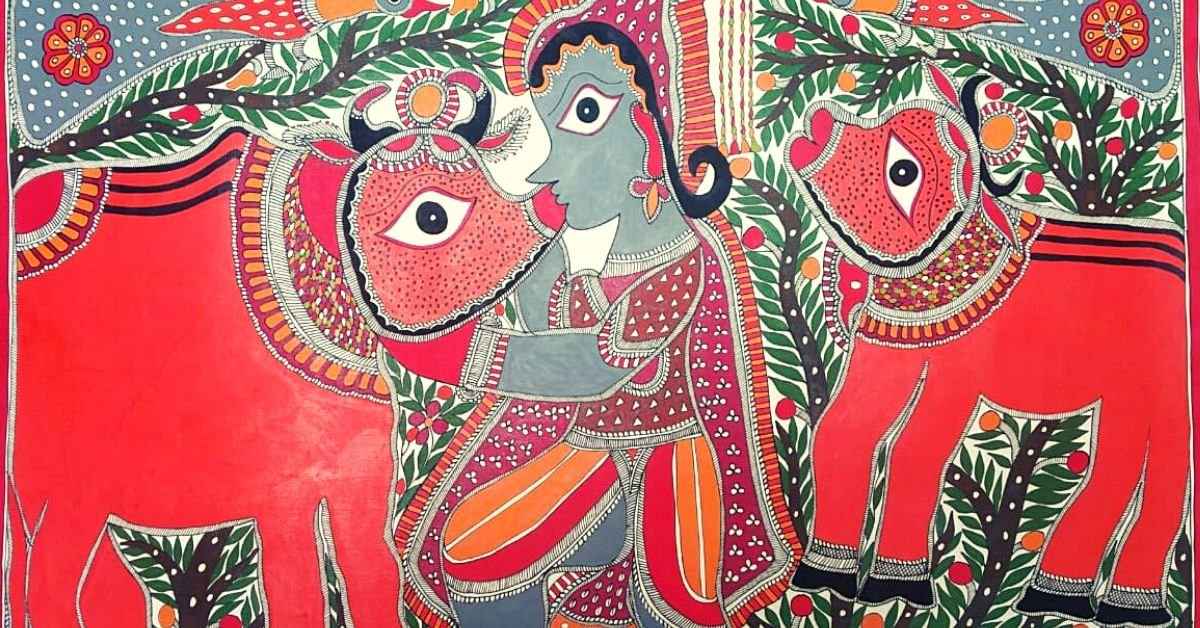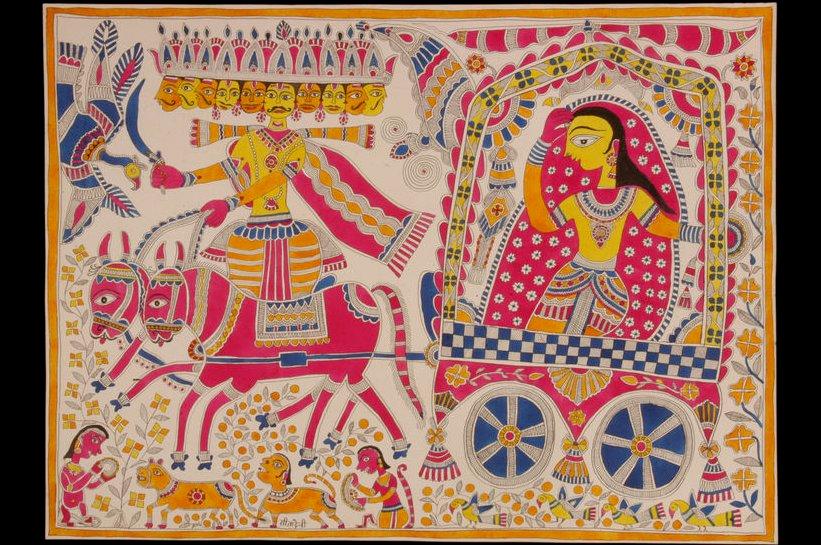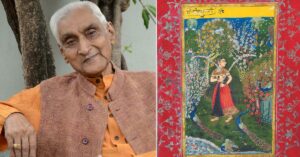How a British Officer Spotted Mithila Art During an Earthquake & Took It to the World
After an earthquake caused destruction in Nepal and Northern Bihar, a British officer spotted Mithila art while inspecting the ruins. Mesmerised by the beauty in the chaos, he decided to take the art form to the world.

In a remote village in Bihar, a group of women huddle around a city wall tracing what appears to be a painting on the blank canvas of mud. To a passerby watching, the art form holds a certain draw with its contrasting dark and bright pigments filled into the tribal motifs.
In a few hours, the painting will be complete — a riot of colour bringing alive a certain traditional folk tale. The beautiful masterpiece will be one among the numerous manifestations of the eponymous Mithila art or as it is more popularly known, Madhubani art.
Today, the art form has travelled from the city walls and mud houses of Bihar to canvases and objects that find a place in big cities, palaces, and even overseas.
The reason for the art form’s overnight popularity lies in its unique discovery.

Beauty in the ruins
In 1934, Nepal and parts of Northern Bihar were victims of a terrible earthquake of 8.0 magnitude. As the destructive tremors ripped the city apart and its residents scrambled to survive, the houses tumbled like decks of cards, leaving behind a cascade of ruins.
Assessing the damage was a British civil service officer, William Archer, who had been posted as the Magistrate in Madhubani just a year prior. The locals knew him as the officer who saw to law and order and often settled their petty disputes.
As Archer made his way into the city, attempting to make sense of the ruins left behind by the calamity, he spotted something in the mess, that caught his eye. This in decades to come would be known as the moment that caused Mithila art to reach the world.
Archer’s diary discovered later sheds light on the exact storyline.
In 1934 an 8.0 magnitude earthquake shattered parts of Nepal and India. Among the worst affected was Northern Bihar. From the horrors of the region, however, a British Civil Servant spotted something magical. A thread on how Mithila art came to light. 1/19 pic.twitter.com/6pnTHhY2df— The Paperclip (@Paperclip_In) February 6, 2023
He writes, “I had ridden out one evening to a village close to Madhubani itself and chanced upon a small white temple. The mahant (priest) invited me to see the image. It was a black stone dressed in doll-like clothes. The houses had been severely damaged yet not so damaged that none were standing. I could see beyond the courtyards into some of the inner rooms; what I saw took my breath away.”
Archer then refers to the murals he witnessed painted on the walls.
“What I was seeing was a marriage chamber, a kobhar. It was here that the bride and bridegroom would be espoused and everything painted was designed to bring them prosperity, good fortune and fertility.”
This, as the world would one day see, was Archer’s first encounter with the famed Mithila art. But as he delved deeper into this area, what astounded him was how different the art form was across households.
As he further writes, “The style of their murals was quite distinct. It presupposed the same liberties, the same repudiation of truth to natural appearances, and the same determination to project a forceful idea of a subject rather than a factual record. But in contrast to Brahmins, Kayastha women were vehement — they portrayed their main subject with shrill boldness, with savage forcefulness”.
“I must confess that for at least an hour, I forgot the earthquake and its horrors. I was entranced by what I saw in these murals we somehow electrically met. What they took for granted, I considered superb…the art was there and made us one…I saw the beauty in the mud.”

From Bihar to the world
Archer was intent on having the world know of this wondrous art form and published a paper in 1949 wherein he highlighted what he saw. But it did not yet manage to grab as many eyeballs as he would like.
So, in 1966 he approached Pupul Jayakar, the then-head of the All India Handloom Board asking her to get in touch with the Brahmin and Kayastha families. The idea was to record a video showcasing the Mithila art. Unfortunately, this plan too remained unsuccessful.
But zealous to see the Mithila art get the recognition it deserved, Jayakar got in touch with Mumbai artist Bhaskar Kulkarni. The duo began training local women of Jitwarpur and Ranti villages in transferring the Mithila art to paper.
The first paintings saw the light of day in 1967 during an exhibition in New Delhi. From there, they went to foreign shores such as Japan, Europe, USSR and the US in 1970.
The Mithila art had got her global stage.
Throughout history, many celebrated filmmakers, journalists and celebrities have carried the baton of the art form to global stages. These include the likes of Erika Moser, a German anthropologist and filmmaker, Yves Vequaud a French journalist and filmmaker, and Raymond Owens an American anthropologist.
They would buy paintings of Mithila art from the locals, sell them in the US and return profits to these artisans.
The question remains, what is so amazing about art that once people set eyes on it, they can’t look away?
A love story of paints
It is postulated that the art form originated in the 7th century BCE when King Janak commissioned these paintings to be done to commemorate the marriage of his daughter Sita to Lord Rama.
The geometric patterns are interspersed with flora and fauna drawings along with depictions of the sun, moon and other natural and celestial elements.
The dyes used are obtained from natural materials — black from cow dung, blue from indigo, white from rice powder and bright colours from flower petals. Care is taken to not leave any empty spaces in the drawing.
As the women in Bihar gather to paint their walls, the city has never looked brighter.
Sources
Mithila Art: Reincarnated from the rubbles of an earthquake by Rajesh Kumar.
Madhubani Art: History, Themes and Characteristics by Misha Jaiswal, Published on 21 March 2021.
Edited by Pranita Bhat
If you found our stories insightful, informative, or even just enjoyable, we invite you to consider making a voluntary payment to support the work we do at The Better India. Your contribution helps us continue producing quality content that educates, inspires, and drives positive change.
Choose one of the payment options below for your contribution-
By paying for the stories you value, you directly contribute to sustaining our efforts focused on making a difference in the world. Together, let's ensure that impactful stories continue to be told and shared, enriching lives and communities alike.
Thank you for your support. Here are some frequently asked questions you might find helpful to know why you are contributing?


This story made me
-
97
-
121
-
89
-
167

















